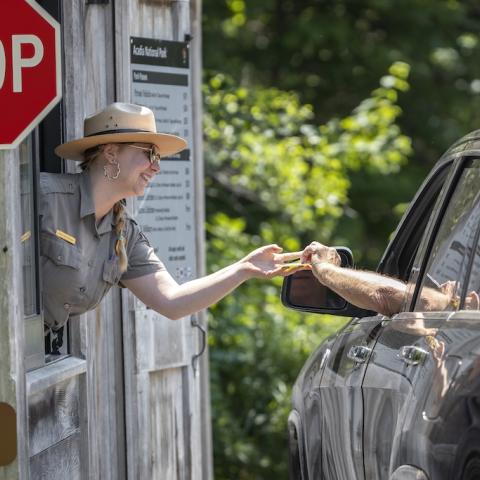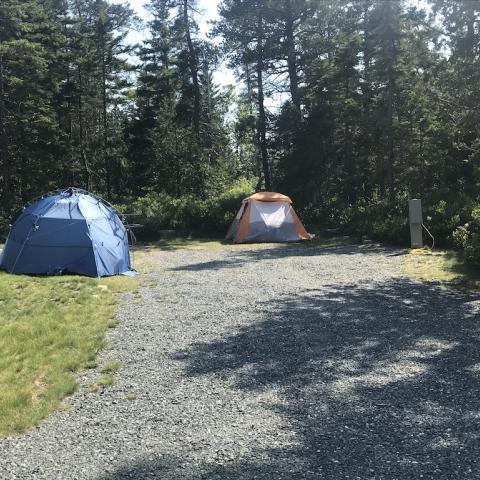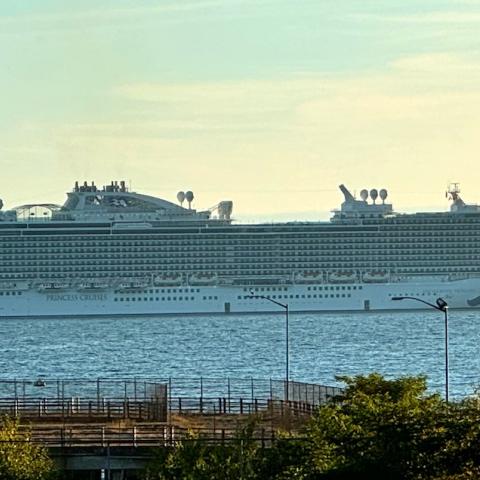
Acadia National Park officials have settled on a timed-entry reservation system to help reduce congestion in their coastal Maine park/NPS file
A "timed-entry" reservation system, one that would give visitors a specific window to enter Acadia National Park in Maine, is being proposed by the National Park Service as a solution to the heavy congestion that clogs Acadia in summer.
The plan, years in development and expected to take years to fully implement, also calls for the eventual phaseout of right-lane parking along the Park Loop Road; construction of a parking lot at a Park Service maintenance yard known as Liscomb Pit; additional parking at Hulls Cove next to the park's visitor center, which would be relocated on site, and; removal of visitor services at the Thompson Island Information Center on the west side of State Route 3, with that area to be restored to natural conditions.
"We believe the preferred alternative as revised in response to public comment best fulfills the purpose and need for the plan and the mission of the National Park Service," Acadia Superintendent Kevin Schneider said Monday. "The preferred alternative provides for the best protection of the significant natural and cultural resources of Acadia National Park while also providing high-quality experiences to visitors. This plan is a blueprint for the future; many of the details related to implementation of the Final Plan/EIS will take years and continue to require public feedback and stakeholder engagement.”
Like many national parks across the country, visitors flock to Acadia in ever-growing crowds, at some times diminishing the experience due to congestion on roadways and crowds at popular sites in the park. The transportation plan Acadia officials are proposing seeks to find a middle ground.
Elsewhere in the National Park System, both Arches and Zion national parks in Utah are working on their own crowd-management plans, and Yellowstone National Park officials in Wyoming in 2017 opened a nearly 1-acre gravel parking area near the Fairy Falls Trail in a bid to reduce illegal parking along the road shoulders. Yosemite National Park staff in California not only have worked to improve parking in the Yosemite Valley, but has experimented with an approach to pace and send vehicles to the Arch Rock Entrance Station.
At Acadia, the Final Transportation Plan Environmental Impact Statement released Monday said the timed-entry reservation system would "initially be implemented incrementally for the Ocean Drive corridor, Cadillac Summit Road, and the Jordan Pond North Lot during peak season (from mid-June to mid-October). During initial implementation of the plan, all other Acadia parking lots would continue to be managed on a first-come, first-served basis."
The proposal, sent to the Park Service's Northeast Regional director for approval, would allow visitors to spend as much time in the park once they entered Acadia. It also acknowledges some tinkering could be required as the plan is implemented.
"The length of the initial entry window may be lengthened or shortened as park managers optimize the reservation system; however, it is estimated that initial timed-entry windows would be in 15-minute to 2-hour time blocks," the EIS said.
It is expected that the reservation system would kick in during the second Friday in June and end the Sunday after Columbus Day, though that window could be stretched or reduced to reflect traffic patterns. Reservations would be required as early as 4 a.m. for visitors wanting to drive to the summit of Cadillac Mountain, and as late as 5 p.m. at the Jordan Pond north lot and along the Ocean Drive corridor, the EIS said.
Park staff estimate that the reservation system could handle 1,460 vehicles per day for Cadillac Mountain, 850 cars for the north lot at Jordan Pond House, and 1,020 vehicles along the Ocean Drive corridor.
If traffic monitoring elsewhere in the park noted congestion problems that were impacting park resources, "access to Island Explorer routes entering the park, vehicle access to other parking lots, or vehicle access to the entire Park Loop Road may be added to the reservation system."
However, park staff also said that expanding the reservation system for the entire Park Loop Road would require "reconfiguring some existing park entrances to be exits only, constructing new or relocating existing entrance stations, and potentially making the entire Park Loop Road one way."
The EIS notes that it long has been the Park Service's intent to end right-lane parking along the Ocean Drive corridor to "restore a driving experience that more closely resembles the road's original design intent and to improve safety by providing an additional travel lane for bicyclists and slow-moving vehicles."




 Support Essential Coverage of Essential Places
Support Essential Coverage of Essential Places







Comments
How about we limit access for non-"America the Beautiful" passholders during peak days/times? The fees for these passes go to pay for the parks, we should get access before busloads of non-passholders. I have no issue with people without passes visiting, but something has to be done about the congestion at parks like Acadia, Yosemite, RMNP, and Yellowstone and passholders should get priority during peak times.
Ok, I don't mean to dismiss Ms. Kingley's proposal completely, just illustrate how the same statement could be easily changed without much effort, and next time you or I might just be on the excluded end of things.
Regarding her specific proposal, I don't know that I want the already long lines at the entrance stations to get even longer waiting for the fee collectors to also perform a citizenship check for each occupant of the vehicle. Nor would I want the limited park resources spent on training entrance fee collectors to properly make citizenship assessments. I may not like the Park's timed entry proposal, but it sure seems easier to implement than a citizenship-checking process.
I wonder if a hybrid system is worth considering. If you want to drive your car into a park, then you need a reservation. But, if you are willing to ride a shuttle, and park off site in a giant parking lot, then you don't. I also wonder if the second might actually be preferred by 'touristas.' As I've written before, I favor breaking down the large tour buses into 12 to 15 person vans, each with a guide.
That's the system at Muir Woods National Monument, more or less. The problem there was never that the park was really all that crowded, but that parking was extremely limited. I've literally parked nearly a mile away after dropping off my group. However, even the shuttle buses from Sausalito/Mill Valley require reservations. No reservation is needed for biking in. I think motorcycles need a reservation though since there are no motorcycle specific parking spaces. One could walk in or be dropped off. I believe tour buses secure reservations ahead of time, so that's one way around the limitations. And it's really about parking, so it might be possible for tour buses to drop off passengers then wait elsewhere.
That doesn't necessarily provide more fees for the parks. Your proposal there would likely reduce total fee collection. For example, The America the Beautiful regular annual pass is still $80. The Yosemite NP vehicle entrance fee is $35. Interagency annual pass fees go directly to a federal recreation general fund that's split between NPS, Forest Service, BLM, Bureau of Reclamation, Army Corps, etc. The current NPS Fee Demonstration Program keeps 80% at the specific park and 20% to a fund for NPS units that charge no fee. Now something like a Yosemite annual pass is part of the Fee Demonstration Program. However, at $70 for a Yosemite annual pass I would easily make the decision for the interagency pass at $80.
If visitation during peak times is restricted to passholders, that doesn't necessarily provide more in fees unless it's for park-specific passholders. Also - it might spur people to get annual passes (just to visit) which would then encourage them to make more visits. Frankly it would make more sense (in terms of money to the parks) if there was a preference for one week/daily fees. Even someone with an interagency pass might consider paying the one week entrance fee if that's the only way to get in.
The way some theme parks work is that they actually limit access to annual passholders when it's too crowded. The rationale is that the non-passholders are actually paying more (compared to annual passes amortized per visit) and often will be the ones that won't be returning soon.
I propose that if you have been to a NP in the last 12 mos you must wait a year to go back....and if your kids were a PINB while there you must wait 5 years....
Why can't all the national parks do what has already been done at the Grand Canyon and a few other parks for years, i.e. restrict all vehcles except for National Park trams or shuttle buses that will take tourists to all the places they want to see more efficiently and without the added hassle of parking at each stop? It works fine in the Grand Canyon, so why not use it at all the other parks as well.
Are you willing to expect the same treatment when Americans go visit the Louvre, Eiffel Tower, Colosseum, etc.?
there is already such a system in place at Joshua Tree NP. We just got back from there and if you ride the free shuttle no entrance fee or long car lines to get in the park.